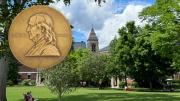this fall, for the first time, undergraduates inspired by I.M. Pei, M.Arch. ’46, Walter Gropius, Rem Koolhaas, Jeanne Gang, M.Arch. ’93, and other great world architects will have a chance to study at the Graduate School of Design (GSD), and possibly start earning graduate credit as early as their senior year.
Harvard’s department of history of art and architecture and the GSD have developed a new undergraduate track in architectural studies to be introduced in the coming academic year. (The track would become a full-fledged concentration if approved by a Faculty of Arts and Sciences vote.) About a dozen students will be accepted into graduate-level classes in the history and theory of architecture, studio courses, and basic architectural techniques, said Oaks professor of the history of pre-Columbian and colonial art Thomas Cummins (who chairs the department within the College).
Cummins said there had been a longtime collaboration between his department and GSD faculty members, so the creation of this undergraduate program of study seems like a natural transition.
“We don’t want to make this a preprofessional concentration that is simply to lead into becoming a practicing architect,” he said. “It will do that, but that’s not the guiding structural or intellectual principal that we are looking at. It’s to give students access to what the GSD does best—the caliber of the faculty and studio courses. The studio courses are now available here instead of [the undergraduates] having to go to MIT.”
As part of their coursework, students will be exposed to everything from Islamic architecture and Asian design to more traditional Western concepts. Concentrators could also apply for an accelerated track so that their senior year at the College would double as their first year at the GSD.
The track’s requirements include “Landmarks of World Architecture,” plus two courses in the history and theory of architecture, two studio courses that will introduce basic architecture techniques, and four courses in an area of focus—either history and theory or design studies.
In addition, it will require a half course in European or North American architecture; Asian, Islamic, African, Indian, Latin American, or pre-Columbian architecture; and one half course on architecture before 1700. Students will write papers and create visual projects, focusing on contemporary architecture as well as “issues of environmental sustainability, new forms of urbanism, and the use of digital media for visualization analysis,” Cummins said. Although internships are not required, Cummins noted the culminating project for students is a thesis—written or a design project—advised by GSD faculty. Peer institutions such as Princeton, Yale, Barnard, and the University of Pennsylvania offer architectural concentrations, but Harvard’s track differs, he noted, due to the close collaboration with the GSD.
“These students will have access to studios and they will produce drawings and diagrams as well as new programs of public space, proportion, sequence,” Cummins said. “They will learn all the kinds of things that are part of the craft and techniques of contemporary architects.”









